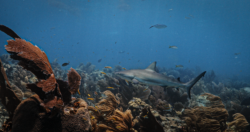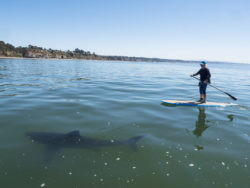
Sharks: Fact or Fiction?

Shark swimming in Papahānaumokuākea Marine National Monument. Photo by John Burns/NOAA
Sharks may be one of our ocean’s most intimidating creatures. The sight of a triangular fin pointing out of the water can inspire fear in many beachgoers. Yet there is more to a shark than meets the eye, and they are a critical part of a healthy marine ecosystem, including many National Marine Sanctuaries. Here we will discuss what is fact- and what is fiction- about our finned friends.
All sharks are large carnivores with sharp teeth- FICTION

A whale shark glides through Flower Garden Banks National Marine Sanctuary. Photo credit: FGBNMS
Picture a shark in your mind- what do you see? Your mental picture might include a large, torpedo-shaped body, with a triangular dorsal fin and a mouth full of sharp teeth. But there are actually over 400 different species of sharks, from the palm-sized dwarf lantern shark to the mighty 40-foot whale shark! Some sharks, like basking sharks, are filter-feeders that swim open mouthed to sift small plankton and krill from the water.
Sharks do not have bones- FACT

Photo credit: Bruce Sudweeks
Sharks, like their relatives rays and skates, are part of a family of fish known as “elasmobranchs”. These fish do not have bones. Instead, their skeletons are made of cartilage, the same flexible tissue that your ears and nose are made of. These skeletons are much lighter than bone, and help sharks remain mobile and buoyant in the water.
Sharks must keep swimming at all times- FICTION

A nurse shark rests on the seafloor in Florida Keys National Marine Sanctuary. Photo credit: Daryl Duda
While some larger pelagic sharks do need to “just keep swimming” in order to push water through their gills to breathe, other sharks, like the nurse shark, can pump water over their gills themselves while calmly resting on the seafloor.
Sharks have an excellent sense of smell- FACT

Photo credit: Nick Zachar
Sharks have an excellent sense of smell, which helps them to locate and identify prey, recognize territorial markers, and even find potential mates. The shark’s olfactory organs, which help it smell, make up approximately two-thirds of its brain.
Sharks are a common danger to people- FICTION

A stand-up paddleboarder and a shark enjoy Monterey Bay National Marine Sanctuary. Photo credit: Bruce Sudweeks
Despite their fearsome reputation, humans are not on the list of a shark’s favorite foods. Most shark bite incidents are a case of mistaken identity, where the shark assumes a human in the water to be a seal or a dolphin. According to the Florida Museum of Natural History’s International Shark Attack File, in 2020 there were 10 shark-related human deaths. You are more likely to be struck by lightning than be killed by a shark. In contrast, humans are one of the biggest threats to sharks. Over 100 million sharks are killed annually by humans.
